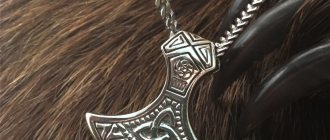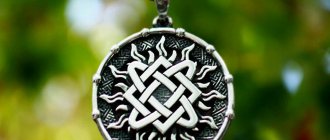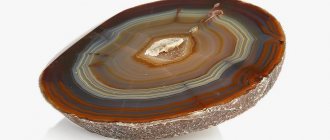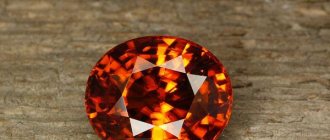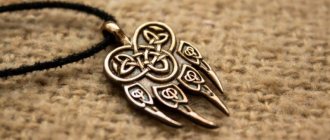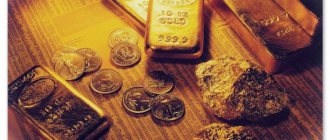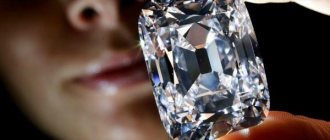History and symbols of the Slavic god Perun
Most often, the image of the deity can be found against the background of lightning. This is due to the fact that his birth took place on a very stormy day, when powerful thunderclaps crossed the sky, and the whole earth trembled from the power of the elements. Later, God grew up and learned to subjugate this natural power, and most of all he liked to control lightning.
The Slavs often associated the first spring thunderstorms with the appearance of Perun. The earth was saturated with rain and the power of heavenly fire, thanks to which it began to bear fruit. Plants more readily emerged from the ground and began to grow. Therefore, the magic of Perun is closely connected with the awakening of all living things and creation.
It is not for nothing that Perun’s mother was the goddess Lada , whose role was to strengthen fertility, preserve the family, and help in bearing offspring. Perun's father was Svarog , the blacksmith god who created all living things by forging the Earth. As a child, Perun early joined his father's business and fell in love with tinkering in the forge. That's why so many of Perun's symbols are associated with weapons: swords, axes, shields - all these attributes are often depicted along with full battle garb.
God used skillful fighting skills only in exceptional cases: he knew about his power and did not show boasting about this, but called on his strength only when it was necessary to restore justice and stand up for ideals . Perun patronized those who stand for a just cause, despised cowards, traitors and hypocrites.
In order to enlist the support of a deity, you must choose one of his symbols. At the same time, it is important to share Perun’s ideology. The power given by the amulets of the Slavic god can only be used for a good deed and act on the side of the light.
Slavic Reza Roda Perun in northern fortune telling
The Reza of God Perun is included in the northern oracle “Slavic Rezas of the Family. Prediction. 40 pcs." The Reza of God Perun is also included in the magic set “Slavic Rezas of the Family. Fulfillment of aspirations. 21pcs"
The Rez depicts God Perun, seated on a rearing horse, holding a two-handed spear at the ready. God is in the midst of battle, his hair flutters back, his gaze is directed forward, straight at the enemy. Looking at the picture, you can describe Perun the Thunderer in one word - Striking!
The amulet symbol of God Perun - Gromovnik is also a symbol of Reza. The sign is located in the center of the bright multi-rayed Sun. Below, under the figure of God and the horse, is the land of Reveal, which He always protects. Even lower is the Name of God and his number – 18.
Cut number – 18.
Fortune telling . Questioning God . “Victory has arrived!” - this is the message of this Reza to the Questioner. It is this cut that appears in the reading when the Questioner is waiting for the end of his battle. The person is encouraged to use his courage and courage to immediately attract supporters to his cause. However, the Questioner himself can become support for those in need.
In the section “Slavic Rezes of the Family”: knowledge about how, where and why God Perun is found in the northern magical tradition, magic and fortune telling.
Gromovik (Thunder Kolo or wheel)
One of the most important signs of Perun is the Thunderer, otherwise called the Thunder Wheel or the Wheel of Perun. Externally, the symbol resembles Kolovrat, which has six rays. Thanks to the Thunder Wheel, God could summon lightning and subjugate their power, which makes the sign the most important attribute of the thunderer.
The warlike Perun was tough and intolerant of injustice; he always fought back his enemies, urging them to follow his example. His favor was on the side of the warriors who were ready to defend their country and clan. Therefore, warriors often used Thunderbolt as a talisman. The sign was applied to armor, weapons or clothing. He protected young men and women, gave them firmness and determination, and cultivated their fortitude.
Do you use such an amulet?
Also, the Wheel of Perun helps in the following points:
- Protects against physical injury.
- Gives masculinity and self-control in difficult situations.
- Protects against magical influences.
- Strengthens endurance and strength.
The amulet also wards off dishonest people and protects from those who could cause harm. Therefore, the sign was often depicted on houses. The Slavs helped that under the influence of Gromovik a person would not be able to lie or follow an unrighteous path.
Question to the expert
Can a child wear such an amulet?
Children are not recommended to wear this sign. Their energy is not comparable to the hard energy of the amulet. Wearing it will make the child callous and cold.
Materials for making a talisman
For those who want to make a Perun amulet on their own, you should know that only natural materials are suitable for this product. It can be:
- silver alloy;
- ash or oak wood;
- cow or goat leather;
- copper;
- gold;
- stainless steel.
You can also embroider the talisman on the inside of your clothing or on the collar of a white shirt. The amulet is embroidered with red wool or cotton threads. The color of the talisman should be bright, like lightning and fire. A metal amulet should be shiny and polished - the brighter it is, the stronger it is.
Ax of Perun
This is one of the military symbols of Perun, which was worn by warriors preparing for battle. The amulet helped them in battles, giving them strength and luck in battle, protecting them from injury and death. He endowed them with divine power and bestowed the favor of the deity. The body amulet has the following properties:
- Increased physical strength.
- Attracting good luck.
- Building confidence.
- Protection from enemies, both in a dangerous situation and in peaceful life.
Do you use such an amulet?
It is best to carry the Ax for young men and boys. Women should wear it only for a time when they have to solve a difficult task and gain strength for it.
Types and meaning
The Slavs used various amulets to gain the protection of God. The symbolism of Perun is, first of all, military paraphernalia. Talismans:
This symbol is used to harmonize one’s spiritual world.
- Gromovnik. The main one among all the others. Its image is a cross with 6 rays and blades, placed in a ring. Serves to protect against injustice, injury, damage, and ill-wishers. It can add courage and physical strength to a person.
- Ax of Perun. According to legend, it was with this weapon that the pagan God defeated the Serpent. Gives the owner the missing strength, adds sharpness and enhances masculine character traits.
- Perun's shield. The image is a drop of water turned upside down with the sharp end down with drawings of other symbols. Helps protect against physical and energy attacks, protect family and clan from harm.
- Perun's flower or "fern flower". Allows you to discover the spiritual side of life and find your purpose in it.
- Perunov's helmet. Gives determination, courage, fortitude and luck.
- Rune. The talisman has different meanings depending on the side. One gives powerful energy, the second helps fight chaos in human life.
- Perunitsa. The image is lightning enclosed in a star. Used to attract good luck and help in difficult life circumstances.
- Star of Perun. This amulet is suitable for managers, employees of the court system and doctors. It helps you make difficult decisions, find the truth, think clearly and carry out your plans.
- Sword. This symbol of Perun will help the owner bring order to life, replenish energy, and protect against black magic.
- Seal of Perun. It is customary to receive the symbol as a gift from the mother, then it protects against wickedness, death in battles, and enemy knowledge.
Symbols should not be used by people who deceive and harm others.
Shield
The shield is less often depicted in drawings of Perun, because its attributes are more related to an offensive weapon than to defensive attributes. However, this element also occupies an important place in divine symbolism, as it reminds that the thunder god is not reckless and cruel, but a wise warrior who stands for truth . Usually the shield is presented in the form of a drop with a pointed end towards the bottom. Sometimes he is depicted together with Gromovik, illustrating a complete set of security items.
Do you use such an amulet?
Perun's shield is only suitable for men. Women are strictly forbidden to wear such a talisman, as it takes away their natural energy. This attribute is closely related to military affairs, which is why wearing it cultivates the energy of aggression for protection. Women can quickly become exhausted and tired of this property of the amulet.
The main tasks of the amulet are similar to the actions of a regular shield. The symbol protects against any type of weapon: physical, psychological, magical. It covers its owner with an energy shell that does not allow negativity to pass through, sheltering from evil and misfortune. It is better to wear such a symbol individually, without depicting it on objects of common use.
Who are they suitable for?
With the help of such a symbol, a woman can demonstrate the qualities inherent in her gender.
Military symbols - Perun's cross, ax and shield - are suitable as amulets for young men over 16 years of age and adult men. It is forbidden for children to wear it as it develops stiffness in them. It is also undesirable to use by women, due to the fact that amulets block the manifestation of female character traits and form masculine ones. For the fair sex, Rune, Perunitsa, Star and Fern Flower are suitable.
The color of Perun is universal in use. Suitable for all genders and ages. It will be especially relevant for people associated with science and knowledge, travelers and military personnel. It will help you find happiness, bring peace to your soul, and find your calling. The talisman should not be used by people who have evil thoughts and want to harm others. It will not suit warlocks and dark magicians, since Perun, although cruel, is a fair God and will not punish anyone in vain. It is also not recommended to be worn by those who think only about material wealth.
Helmet
Another protective symbol of Perun. Its purpose is also similar to the original item: the amulet protects its owner, makes him stronger, and helps him overcome difficulties . The helmet was an integral attribute of military armor, so it is believed that it is it that completes the appearance of its owner, making him maximally protected from attack.
Do you use such an amulet?
He helps the weak become more confident and decisive, and gives warriors good luck and wisdom to act wisely. Since the helmet protects the head, the amulet effectively resists other people's attempts to cloud the mind. Its use helps keep your head clear and sober even in difficult situations.
This symbol is best worn by adult men; for young men it will not be so relevant due to its grounding energy.
Perun named Entil
Among the Sumerians, His name was Enlil - the Heavenly King and “Lord of the Lands”, the Patron of Laws, the Thunder God, the Lord of thunderstorms, storms, winds and floods, the patron of the destinies of people and Gods, bestowing happiness or misfortune, misfortune or good. According to ancient Sumerian myths, Enlil divided Heaven and Earth with a hoe, created the Dawn, gave birth to vegetation on Earth, and invented the plow. Enlil controls a part of Heaven, which is called the “Way of Enlil.” Enlil, whose command reaches far, whose word is holy, God, whose decision is immutable, to whom destinies are entrusted. power, supremacy and kingdom, the Gods of the Earth bow in fear of him, the Gods of Heaven are humble before him... Later, during the time of the Babylonian kingdom, Marduk took on all the features of Enlil.
Sword
The sword is the most traditional symbol of Perun, directly related to military clashes. The Thunder God protects in wearing it only those who behave honestly and with dignity towards other people and themselves. The sword is a symbol of justice and order; it calls these energies into the life of everyone who needs intercession. To dishonest people, hypocrites pursuing selfish interests, such a sign will bring retribution and punishment for their actions.
Do you use such an amulet?
For decent people, Perun’s sword can be useful in the following ways:
- Harmonization of relations with the world: if a person was unfairly deprived of something, he will receive it.
- Restoring vitality.
- Protection from other people's physical and magical attacks
- Filling with strength to carry out justice.
How to use the amulet?
Metal amulets need to be cleaned every six months. The purification ceremony is performed on the full moon. If it is summer, then it is better to clean the talisman after a rainstorm or thunderstorm. The most suitable day is Thursday. Cleansing process:
- The chain or strap is removed from the talisman.
- Place it in cold running water.
- Wax from a church candle is dripped onto the surface of the water to form a cross.
- Leave the amulet in this water on the windowsill until dawn.
Perun's amulets are usually given to boys or men. If you give such a gift to a baby, then by the time they reach adulthood, the amulet will become a powerful protection for its owner. To protect the house from evil forces and enemies, the symbols of Perun are embroidered on tablecloths, curtains and bed linen.
Arrow
Symbol of Perun's patronage, made in the form of an arrowhead. It is advisable to wear the amulet as a body amulet, since its energy must be in constant contact with the owner. The owner of such an amulet will be guided in business: the arrow will always show the right path and help quickly find a way out of a confusing situation. It helps in the rapid progress of things, not allowing the problem to stagnate.
Do you use such an amulet?
Mythology of the Slavic deity
In the folklore of the southern Slavs, the image of Perun was transformed in the most unusual way. During the spring and summer rituals of calling rain in the Balkans, the central character was Peperuda, also known as Dodola, a subject directly identified with the image of the ancient Russian thunderer.
REFERENCE. During the ritual, the main role was given to the girl, decorated with greenery.
The improvised Dodola, being at the head of the ritual profession, visited all the village houses. They poured water over her while singing and dancing. The girl herself had to try to splash as many drops of liquid around as possible.
The owners of the visited houses presented the participants of the procession with gifts. An orphan girl, or the last child born after the death of her father, was usually chosen for the role of Peperuda. If there was a possibility that the mother would give birth to another baby, then the entire village would be in danger of terrible misfortune.
ATTENTION. There is an opinion that initially Dodola portrayed the goddess, the wife of Perun, and those accompanying her were none other than priestesses.
In the folklore heritage of the Eastern Slavs, references to the thunder god pursuing the devil are recorded. This character tried to kill a representative of the dark forces with his striking lightning. The devil hid from his angry pursuer, either in a human body, or in various animals, or in trees and stones. As a result, he went deep into the reservoir, where Perun finally left him alone, deciding that the dark force belonged there.
IMPORTANT. The sacred tree and symbol of Perun is the oak.
An ancient ritual performed by the Slavs on the island of Khortitsa was associated with this representative of the flora. Sharp arrows were placed around the tree, and live birds, mainly roosters, were sacrificed. Each participant in the ritual had to make an offering in the form of bread or meat.
Many archaeological finds of those times were also associated with the Slavic deity. While cultivating the land or building a new house, people often found sharp stones in the soil, which were parts of ancient tools.
These could be spearheads, arrowheads, or remains of axes. People called them thunder arrows. There was an opinion that during a lightning strike, a divine projectile penetrated the earth's surface, and over time came to the surface in this form.
REFERENCE. There was a belief that thunder arrows had magical properties and could be used to treat many diseases.
Perunov flower or fern flower
This sign is available for use by both men and women. It is one of the most peaceful attributes, exhibiting the following properties:
- Gives its owner confidence.
- Protects against diseases.
- Helps unlock inner potential.
- Helps in acquiring and assimilating knowledge.
- Shows a person his purpose.
Do you use such an amulet?
Holidays in honor of the deity
- January 12 is the Day of Perun’s Justice and the Fire Sword. At this time, it was important to run barefoot in the snow early in the morning and dry off with it. Such an action cleansed the soul and gave powerful strength.
- February 2 is a great holiday in honor of the Thunderer Perun. Another name is Gromnitsa. On this day, loud candles were made and charmed with the power of the deity for the whole year. Used in the event of a thunderstorm, so that bad weather would bypass the house.
- July 20-August 2. During this period, the veneration of warriors took place. In those days, the blessing of weapons and amulets was carried out. Men held ritual exhibition fights.
Previous
GodsStribog - God of the wind among the Slavs: Symbols and signs, myths and legends
Next
GodsDazhdbog: Slavic god also called Tarkh, his symbols, legends about him and mythology
Star
Another universal symbol that helps people in times of peace. It grants the owner wisdom and insight. Develops intuition, makes it possible to look into the future, make correct forecasts and choose the best tactics of action. It helps you look at the situation without embellishment, soberly assessing your capabilities. At the same time, the star of Perun gives hope and inspiration to realize plans for the future.
Do you use such an amulet?
Image in tattoo
Perun's sign can be used as a body image. This symbol will become an excellent protector for everyone who honors their family and preserves the heritage of their ancestors. A tattoo with one of the symbols of God gives its owner strength and courage. It helps you gain wisdom and become more fair.
Choosing a specific sign to apply to the body requires great care. Despite the general warlike energy, each symbol has its own shade.
It is important to consider that the signs of Perun and Veles are incompatible. There are many legends about the confrontation. Women should not get such a tattoo. They can use the hard energy of the deity only as a temporary symbol or amulet.
The Rune is considered an undesirable sign for a tattoo. If the symbol turns over while moving, it will begin to change its meaning. This will lead to negative consequences for the person.
A tattoo with such a symbol has powerful protective properties.
The signs of Perun are distinguished by their amazing diversity. They have different meanings and energies. To choose the best option, you need to take into account your goals and objectives.
Perunitsa
This sign is intended primarily for women, which distinguishes it from other attributes of the thunder god. Some believe that his daughter was called Perunitsa, others pointed to his wife. Be that as it may, the symbol is intended to provide protection and inspiration to people in a state of battle.
He demonstrates that a woman matters not only as a mother or wife, but also as a faithful companion to her man. Therefore, Perunitsa favors persistent, courageous women, gives them strength and support, inspires and ensures inner peace, even if outwardly things are unstable.
Do you use such an amulet?
Amulet helmet of Perun for the protector of his family and land
The Perun helmet amulet usually has the inscription on it: “Who, if not me, will protect your living, not your dead.” According to legend, this saying meant the need to defend the elderly and children, which every Slav felt at the end of a peaceful period of history.
Perun's helmet diverts danger from the warrior, protects him from enemy weapons and sneaky shots in the back. It was worn by both adult men and boys, from whom their fathers were determined to raise warriors. The amulet gives courage, determination and willpower. It is great for developing the inner qualities of a real man.
For the most part, Perun's amulets are intended for warriors, defenders of their family and native land. Nowadays, not only a military man can be called a protector, but also any person whom his family recognizes as the head of the family. The helmet of the Slavic deity will protect you from dangers and help you better perform your functions as a protector.
Rune of Perun
This is a powerful magical symbol and is not recommended for permanent use. You can tell fortunes through runes by connecting to divine energy, but a person quickly gets tired of such interaction, so contact with a magical object should be limited. As an amulet, the rune attracts powerful energy flows into the life of the owner, which will give him great opportunities.
However, it depends only on the person himself whether he will be able to grab what is offered and use it, or whether he will miss the chance, unable to cope with the power of this force.
Do you use such an amulet?
Capabilities
Based on the fact that Perun was a thunderer, he knew how to cause strong thunderstorms. God not only threw lightning for his own pleasure: with their help he punished people who angered him. Usually the unwanted ones were burned alive on the spot. Those who managed to survive were considered almost saints. The lucky ones were called “marked by Perun”, because after the incident they usually discovered hidden magical powers, healing skills and extrasensory abilities.
And Perun himself, the god of thunder and lightning, was an excellent magician. He flew across the sky in a chariot and knew how to transform into different animals, birds, and people. At his own request, he created ghostly creatures, which he sent to mortals with a specific mission. In addition, Perun had enormous physical strength; it was not for nothing that he was compared to an oak tree. By the way, the Slavs were so afraid of the Thunderer that they never cut down these trees. They revered the oak tree that was struck by lightning with double rapture: the wands and clubs cut from its trunk were considered the best weapons not only in the battle with mortal enemies, but also with magical creatures from the afterlife of Navi.
Seal of Perun (Triskele)
Another male amulet, which was usually received from the hands of a woman. Usually the amulet was worn by the head of the family, since its use implied certain obligations to the family and clan. A person with such an amulet was recognized as the protector of the house and its keeper; he was responsible for the decisions made and their consequences.
Do you use such an amulet?
The seal of Perun cultivated the best masculine qualities: endurance, courage, composure, prudence, determination. It is well suited for people whose work involves daily decision-making, establishing truth and justice.
Star of Perun - symbolism of a protective nature for a defender and judge
Star of Perun
The Star of Perun, like most protective symbols dedicated to this deity, is not intended for everyone. Such a talisman can be worn by a person who is considered a defender or arbiter of justice. In the old days, these were the military, guards, and also the rulers of the state.
Now the Thunderer's star can become a good amulet for a judge. It will help you make the right and fair decision, preventing a criminal from going unpunished and an innocent person from ending up behind bars. This talisman is also good for a policeman or prosecutor.
In addition, such a star will be an excellent amulet for a person who is at the origins of any business. If you are the leader of any team or enterprise, your professional activity is related to management, justice is inherent, then this talisman will help you better cope with your professional responsibilities.
This symbol is often called differently - the cross of Perun, but these are different symbols. The cross looks like a four-pointed star. Not much is known to modern people about this protective symbol. This symbol, according to legend, bestowed the favor of the deity on representatives of the specialties that he patronized.
Interesting video on the topic
The story of Perun’s birth and growing up, his role in the Slavic pantheon of gods, depiction options, a story about attributes and divine commandments:
The attributes of the thunder god are very diverse, both in form and in essence. Among the signs there are amulets suitable for both women and men. They can be used for personal protection or to protect home and family. The most important thing when wearing the symbols of the Slavic god Perun is to comply with the established divine rules, use power for good, and bring justice and goodness to the world.
Divine attributes
Each Slavic deity had his own personal attributes, designed to denote power in the real world. Perun's symbols are:
- Vocation – justice and war.
- The name is striking, slaying.
- Patronage of blacksmiths by warriors.
- The fire element, expressed in lightning and thunderstorms.
- Sacred animals – horse and wolf.
- The sacred bird is the eagle.
- Combat attributes - axe, axe, mace, sword.
- The sacred plant is perunica or iris.
- The sacred tree is oak.
- The sacrifices are bread and salt, a bull or a rooster.
- The sacred day of the week is Thursday.
- Idol is crazy.
Notes
- ↑, p. 68.
- , With. 62.
- Brückner A.
Słownik etymologiczny języka polskiego. - Warszawa: Wiedza Powszechna, 1985. - S. 414. - , With. 7-11.
- Trubachev, O. N.
Ethnogenesis and culture of the ancient Slavs. - M.: Nauka, 2003. - P. 197. - Zarys dziejów religii. / Joseph Keller; Jozef Bielawski. —Wyd. 6. - Warszawa: Wydawnictwo ISKRY, 1988. - S.263. - 814, s., s. — ISBN 8-32-071069-3
- ↑
- Gamkrelidze, T. V.;
Ivanov, Vyach. Sun. Indo-European language and Indo-Europeans. - Tbilisi: TSU Publishing House, 1984. T. II. - pp. 792-793, 798. - ↑
- Quote by: , p. 72.
- “And on the morning Igor called his words and came to the hill where Perun stood, and laid down his weapons and shields and gold; and go to Igor’s company and his people, who are so filthy of Rus',” op. by: , p. 73.
- Quote by: , p. 73-74.
- See essay on historiography:, p. 142-146.
- ↑ .
- Oaths in the names of gods were widespread in Scandinavia, but oaths supported by the name of Thor occupied a special place among them, see: Meyer EH
Mythologie der Germanen.
- Strassburg, 1903. - S. 290
. - ↑ Quoted. by: , p. 76
- A mustache or beard is an indispensable attribute of the Thunderer among Indo-European peoples, and the silverness of the head may indicate age. See, p. 15-16
- V. J. Mansikka believes that in the original version of the chronicle only Perun was mentioned, and the names of the other gods were a later insertion, a random set of names of pagan deities known to the scribe. Kh. Lovmyansky, like Mansikka, believes that the chronicle initially contained only the name of Perun, and Nikon Pechersky attributed the rest of the deities to the chronicle, since he imagined Vladimir to be an idolater-polytheist. Before that, Nikon lived in Tmutarakan, in the south, which is why there are so many deities of Iranian origin in Vladimir’s pantheon: Łowmiański H.
Religia Słowian i jej upadek (w. VI-XII). - Warszawa: Państwowe Wydawnictwo Naukowe, 1986. - S. 113-118. Klein believes that the essence of the reform was the establishment of the state cult of the supreme deity, Perun: see, p. 147-151. - Vasiliev, M. A.
Vel. book Vladimir Svyatoslavich: from pagan reform to the baptism of Rus' // Slavonic Studies. - 1994. - No. 2. - P. 38-55. - It is quite possible that the name of the Peryn tract was linked by local residents with the idol of Perun thanks to folk etymology, due to the similarity of sound.
- , With. 160-164, 152-157.
- On this, see Petrov A.V.
From paganism to Holy Russia. Novgorod strife (to the study of the ancient Russian veche way of life). - St. Petersburg, 2003. - Yanin, V. L.
Church of Boris and Gleb in the Novgorod Detinets: (About the Novgorod source of the life of Alexander Nevsky) // Culture of medieval Russia. - L., 1974. - P. 91. - Yakushkin, P.I.
Travel letters from the Novgorod and Pskov provinces. - St. Petersburg, 1860. - P. 118. - Vasiliev, M. A.
Paganism of the Eastern Slavs on the eve of the baptism of Russia. - M.: Indrik, 1999. - P. 311. - Ukrainian fairy tales. - M., 1993. - Book. 2: Magic spring. — P. 50-51. — The tale was recorded by D. I. Yavornitsky in 1905 in the Yekaterinoslav province.
- Lyubavsky, M. K.
History of the Western Slavs. - M., 1918. - P. 83. Lyubavsky himself refers to the Pomeranian historian Thomas Kantsov. - , With. 143.
- , With. 109.
- , With. 104-114.
- The name of Perun in these songs is usually replaced by the word God.
- See, for example, the chant: Rain, rain, let it go, / I’ll go between the bushes / to pray to God, / to worship Christ.
/ God’s orphan, / I open the gates / With a key, a padlock, / A golden handkerchief. - People's wisdom. Human life in Russian folklore. Vol. I. Infancy. Childhood. - M.: Artist. lit., 1991. - P. 242. - Belarusian collection. Vol. 4. Cosmogonic and cultural tales. - Vitebsk, 1891. - No. 1, No. 3 and comm.; , With. 5, etc.
- , With. 164 et seq..
- Veselovsky A. N.
Favorites: traditional spiritual culture. - M.: ROSSPEN, 2009. - P. 207-208. - , With. 7 et seq..
- , With. 12 et seq..
- Gamkrelidze T.V., Ivanov V.V.
Indo-European language and Indo-Europeans. - Tbilisi, 1984. T. 2. - P. 618. - , With. 21-22.
- , With. 89-92.
- , With. 233.
- , With. 24-25.
- Rybakov B. A.
Paganism of Ancient Russia. - M.: Nauka, 1987. - P. 178. - , With. 98.
Etymology
The Slavic etymology of the name Perun (Proto-Slavic *Perunъ) is shared by most researchers. It is believed that it comes from the verb *perti, *pьrǫ
“to hit, beat” (cf. Russian peret, Bulgarian pen, trans. “I beat, beat”) and the suffix of the figure
-unъ
(cf.
runner, jumper,
and so on).
Thus, the name Perun
means “beating, striking, striking (with thunder and lightning).” In Slavic languages there are identical words for thunder and lightning - Russian. Perun “lightning” (obsolete), Ukrainian. Perun, Belarusian Pärun, Polish piorun "thunder".
A number of researchers compare the name of Perun with the names of the Thunderer (and other gods) among other Indo-European peoples - from lit. Perkūnas, Latvian. Pērkons, other Indian Parjánya, Hittite. Pirwa-
etc. Directly linking the name of Perun with the names of other Indo-European thunderers is not entirely legitimate.
These words go back to the same root * per
, however, the name of the Thunderer among the Balts and Indo-Aryans has the suffix
-k-
, which is not in the Slavic *
Perunъ
.
Therefore lit. Perkūnas, Latvian. Pērkons et al. Parjánya is derived from the Proto-Indo-European name for oak - * perkṷu-
, since the oak was considered the sacred tree of the Thunderer.
This word was not preserved in Slavic languages, since even in ancient times it was taboo due to its sacredness. In addition to the oak tree, the name of the Thunderer in the Indo-European perspective is compared with the name of the hill - Gothic. fairguni "mountain", Hittite. perunas
“rock”, Old Indian parvata - "mountain". This allows researchers to reconstruct the connection of the Indo-European Thunderer with an oak grove on the top of a mountain where lightning strikes.
Some researchers fundamentally separate Proto-Indo-European *perō(ṷ)nos “thunder, thunder god” and Proto-Indo-European *perūn(V) “mountain”, objecting to their relationship. The rapprochement between them, they believe, could only happen secondarily, as a result of popular rethinking.
First feat
It was he who elevated Perun to unprecedented heights in the divine pantheon. And this is not surprising. The gods of the Slavs - Perun in particular - were partial to battles and battles. The Thunderer underwent his baptism of fire during a fight with an ugly Scepter - half snake, half scorpion. By overthrowing him, he earned the respect of higher powers, as well as mere mortals. After this, other battles of Perun followed: he killed the children of Chernobog, the evil lord of the dark forces, and defeated griffins and basilisks. For his indomitable fearlessness and boundless rage, he was made the main defender of the worlds of people and gods - Reveal and Rule.
Reading ancient written sources, for example, the manuscript of Procopius of Caesarea, dating back to the 6th century, one can assume that Perun was considered the supreme god. With the rays of his glory, he eclipsed even his father and grandfather - Svarog and Rod. And this is natural: Perun was the patron of warriors. And Rus' for most of its history was in a state of bloody war, the poet Perun was regularly and generously pleased with gifts and sacrifices.
